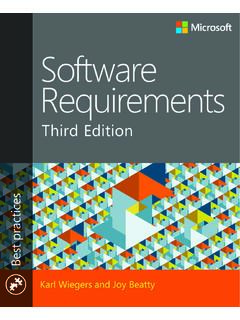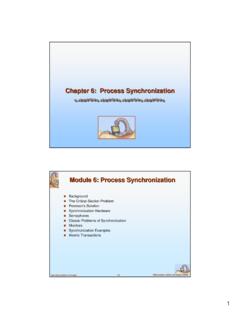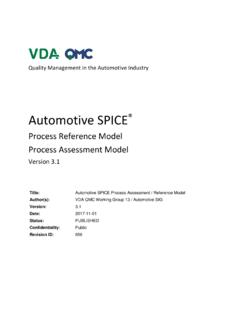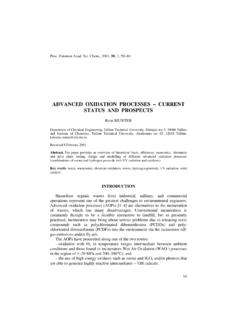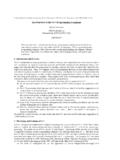Transcription of So You Want To Be a Requirements Analyst - Process Impact
1 Copyright 2003 by Karl E. Wiegers. All Rights You Want To Be a Requirements Analyst ?1 Karl E. WiegersProcess it explicitly or not, someone always performs the role of Requirements Analyst on asoftware project. The official title may be Requirements engineer, business Analyst , systemanalyst, product manager, or simply Analyst , but someone needs to translate multipleperspectives into a Requirements specification and communicate with other stakeholders. Perhapsmost importantly, the Analyst helps determine the difference between what customers say theywant and what they really need and that s easier said than Principal ConduitThe Requirements Analyst s primary responsibility is to gather, analyze, document and validatethe needs of the project stakeholders. As the principal conduit through which Requirements flowbetween the customer community and the software development team, you ll play a central rolein collecting and disseminating product information, whereas the project manager takes the leadin communicating project information (Figure 1).
2 Requirements Analyst is a project role, not necessarily a job title. One or more dedicatedspecialists can perform the role, or it may be assigned to any of a number of team members: theproject manager, product manager, subject matter expert, developer or even a user. Nevertheless,a talented Analyst can make the difference between project success or failure. In his book,Software Cost Estimation with Cocomo II (Prentice Hall PTR, 2000), Barry Boehm notes thatseasoned analysts can reduce a project s required effort by one third compared to similar projectswith inexperienced analysts, and projects with highly skilled analysts require half the effort ofthose using the least capable Analyst s TasksStraddling the gulf between vague customer ideas and the clear specifications that will guide thesoftware team s work, the Analyst must first understand the users goals for the new system andthen define functional and quality Requirements that allow project managers to estimate,developers to design and build, and testers to verify the product.
3 You can download a generic jobdescription for a Requirements Analyst from Hereare the typical activities that you ll perform while wearing the Analyst s Business Needs. Your work begins when you help the business sponsor or the productmanager define the project s business Requirements . The first question to ask is, Why are weundertaking this project? Business Requirements include a statement of the organization s 1 This paper was originally published in Software Development, July 2003. It is reprinted (withmodifications) with permission from Software Development You Want To Be a Requirements Analyst ?Page 2 Copyright 2003 by Karl E. Wiegers. All Rights objectives and the ultimate vision of what the system will be and do. Working with thepeople who hold this vision, you ll help them express it by completing a vision and scopedocument template (download a sample at ).
4 Identify Project Stakeholders and User Classes. The vision and scope document helps youidentify the product s important user classes and other stakeholders. Next, work with thebusiness sponsors to select appropriate representatives for each user class, enlist theirparticipation and negotiate their responsibilities. Write down the contributions that you d likefrom your customer collaborators and agree on an appropriate level of participation from Requirements . Requirements for a software product don t just lie around waiting forsomeone to collect them. A proactive Analyst helps users articulate the system capabilities theyneed to meet their business objectives. Users naturally emphasize the system s functionalrequirements, so steer discussions to include quality attributes, performance goals, businessrules, external interfaces and constraints. It s appropriate to challenge assumptions, but don t tryto force-feed users your own Requirements .
5 Look for derived Requirements that are a logical consequence of thecustomers requests, as well as hunting for those implicit Requirements that they expect butFigure 1. The Requirements Analyst bridges communication between customer anddevelopment representativesother stakeholderstestingdevelopmentproject managementproject sponsorRequirementsAnalystbusinessrequir ementssize andcomplexityinformationexpectationsand constraintsfunctional andnonfunctionalrequirementsuser requirementsfunctional andnonfunctionalrequirementsSo You Want To Be a Requirements Analyst ?Page 3 Copyright 2003 by Karl E. Wiegers. All Rights t verbalized. Spot the vague, weak words that cause ambiguity and confusion. Point outconflicting Requirements and areas that need more detail. Specify the functional Requirements at asuitable level of detail for the developers who implement them. A website being builtincrementally by a small, well-synchronized team can get away with limited requirementsdocumentation, but a complex embedded system to be outsourced to an offshore supplier needs aprecise, detailed software Requirements specification (SRS).
6 Write Specifications. Effective Requirements development leads to shared understanding andcreation of a system that addresses the customer s problem. You re responsible for writing well-organized specifications that clearly express this shared understanding. Employing standardtemplates for use cases and the SRS accelerates Requirements development by reminding you oftopics that you need to discuss with users. You can find some sample templates the Requirements . You ll need to determine when it s helpful to represent requirementswith nontextual media, including graphical analysis models, tables, mathematical equations,storyboards and prototypes. Analysis models depict information at a higher level of abstractionthan does detailed text. To maximize communication and clarity, draw analysis modelsaccording to the conventions of a standard notation such as the Unified Modeling Validation.
7 You must ensure that the documented Requirements satisfy customer needs andthat they re clear, complete, correct, feasible, necessary, traceable, unambiguous, verifiable andso on. Analysts are the central participants in peer reviews of Requirements documents. To ensurethat Requirements are interpreted correctly, you should also review designs, code and test casesbased on the Requirements Prioritization. You ll broker collaboration and negotiation among the various userclasses and developers to ensure that the right people make sensible Requirements . After establishing the Requirements baseline, your focus will shift tomanaging those Requirements and verifying their satisfaction in the product. Storing therequirements in a commercial tool designed for this purpose can ll want to track the status of individual functional Requirements as they progress frominception to verification in the integrated product.
8 Collect traceability information from teammembers to connect individual Requirements to other system elements. This data will aid inmanaging changes to the baselined Requirements within a change control Process and SkillsAn effective Analyst combines strong communication, facilitation and interpersonal ability withtechnical and business domain knowledge and the right personality for the job. Patience and agenuine desire to work with people are key success factors. Here are 10 soft skills that you llneed to Listening. Active listening involves eliminating distractions, maintaining an attentive postureand eye contact, and restating key points to confirm your understanding. You need to grasp whatpeople are saying and also to read between the lines to detect what they might be hesitant to how your collaborators prefer to communicate and try to avoid imposing your personalfilter of understanding on what you hear the customers say.
9 Watch for assumptions that underlieboth what you hear from others and your own You Want To Be a Requirements Analyst ?Page 4 Copyright 2003 by Karl E. Wiegers. All Rights Interviewing and Questioning. Most Requirements input comes through discussions, so ananalyst must be able to ask the right questions. For example, users naturally focus on thesystem s normal, expected behaviors. However, every programmer knows how much code isneeded to handle exceptions. Ask questions such as, What should happen or Could<some problem> ever arise? so you can determine how the system should handle anticipatedexception conditions. With experience, you ll become skilled in the art of asking questions thatreveal and clarify uncertainties, disagreements, assumptions and unstated expectations. DonaldGause and Gerald Weinberg describe context-free questions in Exploring Requirements :Quality Before Design (Dorset House, 1989).
10 3. Analytical. You ll need to be able to operate at various levels of abstraction. Sometimes youmust drill down from high-level information into details. In other situations, you ll need togeneralize from a specific need that one user described to a set of Requirements that pertain to awhole class of users. Critically evaluate the information gathered from multiple sources toreconcile conflicts, separate user wants from needs, and distinguish solution ideas Facilitation. Requirements elicitation workshops are a common technique; to succeed, theyrequire a neutral facilitator. You ll need strong questioning and observational skills to helpgroups build trust and to improve the sometimes tense relationship between business andinformation technology staff. In Requirements by Collaboration: Workshops for Defining Needs(Addison-Wesley, 2002), Ellen Gottesdiener provides a wealth of advice for the Observation.




